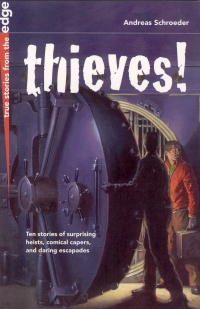| ________________
CM . . .
. Volume XII Number 7 . . . .November 25, 2005
excerpt:
The above is an excerpt from “Banknotes from Heaven,” one of 10 true tales of criminal thievery in the book, Thieves! All these tales are retold, based on identified source evidence, by Andreas Schroeder, a BC writer. An earlier book in the same series, Scams! won him the Red Maple Award (Non-Fiction 2005). The stories are all well chosen and well told. “Bank Notes from Heaven,” noted above, is set in a small Ontario town in 1949. The writing, itself, is clear and easy to read. It is also full of excellent descriptive passages that establish place and time. The invented dialogue is very good, creating mood and action. And Schroeder is outstanding at setting the story’s tone: dramatic, comic, or mysterious. The above quotation is a fine example of setting place and time, and of the humorous tone. These bank robbers are not used to dealing with small town branches and find themselves constantly surprised by how this banking system works. Their ignorance interferes with their usually successful plans. Their getaway plan is foiled when the pilot of the seaplane they have hired leaves them alone awaiting takeoff and never returns. They wait patiently and finally, desperately, attempt to fly the plane themselves. Hilarious disaster ensues. Other stories include the theft of the “Mona Lisa” (Paris, 1911) in which an Italian-born workman at the Louvre Museum is hired with two colleagues to pull an inside job. The theft is successful, and the painting is safely lodged in Vincenzo Perugia’s apartment. Now he awaits the second part of his fee, which he will receive when he hands the painting to Signore. Years pass, and the painting is never claimed. Finally Perugia is broke and decides to repatriate Leonardo Da Vinci’s painting to Italy. He is arrested the moment he tries to sell it to a dealer in Florence. The painting is returned to the Louvre. But the mystery remains: why was it never claimed? Here, Schroeder turns to the book, The Day They Stole the Mona Lisa, by Seymour Reit (1981), to continue the story. The real plot actually began a year before the theft when Signore (who is identified in the book) had six fake Mona Lisas painted. He found six customers who wanted to buy the painting that he said he was about to steal. All he needed for his scheme to work were new reports that the real painting had been stolen: this would convince his six customers that the fakes they received and paid for immediately were genuine. Worth noting is the book’s attractive cover illustration by Scott Cameron. A two-meter-high, round, bank-vault door has been slightly opened to show a caged interior that emits light. This sole source of light reveals two human figures, one opening the vault door, with his back to us, and one the criminal who looks cautiously off the cover, to the right. The list of sources in the back of the book provides further reading opportunities for those readers who want to know more. This is an excellent addition to a non-fiction book, one which encourages its readers to consider more non-fiction reading. Younger readers will find the language easy to comprehend. The writing style is straightforward and should pose no difficulty at all. The content is so strong, after my grades 4-7 recommendation, based on required reading ability, I also recommend this book for young adults with reading difficulties (especially boys) right up to grade 10. Highly Recommended Michael Groberman is a library student at the University of British Columbia with a special interest in children’s literature.
To comment
on this title or this review, send mail to cm@umanitoba.ca.
Copyright © the Manitoba Library Association. Reproduction for personal
use is permitted only if this copyright notice is maintained. Any
other reproduction is prohibited without permission.
NEXT REVIEW |
TABLE OF CONTENTS FOR THIS ISSUE
- November 25, 2005.
AUTHORS |
TITLES |
MEDIA REVIEWS |
PROFILES |
BACK ISSUES |
SEARCH |
CMARCHIVE |
HOME |
